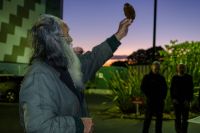Kaikōmako manawa tāwhi (Pennantia baylisiana) returned to iwi
One of the world’s rarest trees has potentially been saved from extinction and returned to its rohe.
Pennantia baylisiana, once in the Guinness Book of Records as the world’s rarest tree, was successfully propagated by scientists in the 1980s and then grown on to produce hundreds of saplings – reducing its risk of extinction.
Manaaki Whenua partnered with Canterbury Museum to purchase and return more than 200 saplings to Ngāti Kuri, who planted them around Ngātaki, close to 90 Mile Beach.
Ngāti Kuri executive director Sheridan Waitai likens the return of the taonga to an intergenerational journey.
‘It’s hugely significant in the sense that it’s part of our identity and it’s also about how we restore and revitalise our whenua, back to how it was in our tupuna time,’ Ms Waitai says.
For decades the only wild female tree remained, growing precariously on a steep, rocky slope on the isolated Manawa Tāwhi (Great Island), one of the Three Kings Islands, north of Cape Reinga.
The tree, also known as ‘Kaikōmako Manawa Tāwhi’, which has never been observed to set seeds, was visited in 1945 by Professor Geoff Baylis, who brought a cutting back to Auckland and nurtured it to maturity at the Department of Scientific and Industrial Research (DSIR).
Forty years later, geneticist and mycologist Dr Ross Beever, a scientist from Manaaki Whenua, noticed that the cutting-grown female plant had produced fruit on a cluster of flowers, however it withered, and no viable seeds were produced.
Dr Beever applied a plant hormone to the seed head, enabling it to produce mature seeds. Manaaki Whenua senior researcher Peter Bellingham says the return of the kaikōmako is a step forward in how science can be done working with Māori on long-term answers to conserving our unique ecosystems.
‘Ngāti Kuri want to reclaim and reaffirm their role as managers of their ecosystems and bring a lot of their own knowledge to problems. This process acknowledges the long history and deep connection to natural ecosystems that Māori have. As scientists, we can bring the training and experience we have to work alongside Maori.’

Karakia by Matua Koro te Pania for the hikoi carrying kaikomako (Pennantia) up to the Far North to Ngāti Kuri where they will be welcomed on to Te Hiku o te Ika, Ngataki.

A close up of new growth on one of the world's rarest trees, kaikomako (Pennantia).

Robyn Simcock carries a young plant to the truck where the kaikomako (Pennantia) will be taken up to the Far North to Ngāti Kuri where they will be welcomed on to Te Hiku o te Ika, Ngataki.

The last wild plant on Manawa Tāwhi

Flowering Pennantia baylisiana

Northern slope of Manawa Tāwhi where the lone wild Pennantia baylisiana grows
Dr Bellingham says that returning the trees is the same as welcoming home a long-lost relative and giving them a home.
‘Theirs is an important rohe to work in because there are many plants and animals in it that are found nowhere else. The kaikōmako Manawa Tāwhi is just one of those.’
Ms Waitai says the young plants generated by Manaaki Whenua are similar in age to the mokopuna of Ngāti Kuri, and bringing the tree back to the Waiora marae has created a visual representation of the returned taonga.
‘This is the first time our mokos get to meet their taonga, their relation. It’s about restoring the relationship between our species, our taonga and us with our whakapapa.’
‘It’s an intergenerational healing and restoration of the Ngāti Kuri land.’
‘Manaaki Whenua bringing our mokos home is part of that reconciliation and forgiveness. Through that what we have learnt together is that for taonga that is on the brink of extinction, together, we can bring them back so with science and mātauraunga Māori, with lots of aroha, we can actually bring back the life to this land the way it used to be.’
She says the Kaikōmako is one of many taonga species and is just the first that Ngāti Kuri –working alongside Manaaki Whenua – could potentially repatriate.
‘I’m really proud to be part of the link in the chain of Ngāti Kuri generation. I have been so privileged to be a part of this journey,’ Ms Waitai says.
